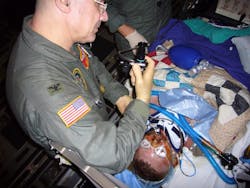Army asks industry to develop handheld sensor to help care for military burn victims on the front lines
FORT DETRICK, Md. – U.S. Army battlefield medicine experts are asking industry to develop a rugged handheld device that measures the severity of burns on wounded soldiers to help medical personnel determine the best triaging and treatment in field hospitals.
Officials of the Medical Technology Enterprise Consortium (MTEC) in Summerville, S.C., issued a request for project proposals (MTEC-22-08-BDA) on Friday for the Burn Digital Assessment project.
The project seeks to develop a handheld rugged sensor able to measure burn severity by calculating burn size and depth, including how much of the victim's body is burned, and at what depths.
This handheld device will be for Army battalion aid stations, brigade support aid stations, forward resuscitation and surgical detachments, and field hospitals to inform triaging, evacuation, and resourcing to help reduce the surgical burden return injured soldiers to duty.
Related: Pentagon eyes hand-held detector to protect warfighters from biological warfare attacks
The MTEC is issuing this solicitation on behalf of the Army Medical Research and Development Command at Fort Detrick, Md. The MTEC is an organization of industry, academia, and non-profit groups that develop medical solutions that prevent and treat injuries and restore warfighters to full health.
Future military engagements likely will result in higher numbers of casualties with significant burn injuries -- including larger, more severe burns, Army researchers say. This will require medical providers to manage burn casualties for longer periods in the field close to the fighting.
Military medical personnel will face deciding how best to resuscitate those casualties and whom to prioritize for evacuation. Today's field hospitals have only minimal burn wound management tools, so determining resuscitation needs and evacuation priority can affect return-to-duty rates and survivability.
Related: The new era of high-power electromagnetic weapons
It is extremely challenging for far-forward medical providers to assess burn severity, because they can only estimate the depth and severity of burns. This is where a new digital assessment device comes in.
This handheld device could help medical personnel evacuate severe burn victims quickly, while preventing unnecessary evacuation for less severe burn casualties who could be treated closer to their units.
Such a handheld device for burn assessment should have FDA clearance for assessing burn size and depth; be able to measure burn size in terms of total body surface area; be able to measure of the proportion of total body surface area for burn depths; be painless; simple to use; give output information within minutes; is compatible with other burn and lifesaving treatments; has minimal training requirements; follows military cyber security requirements; and could become a commercially viable product.
Related: High-energy laser weapons move quickly from prototype to deployment
Those selected for the project will split as much as $4.8 million over two years; several contract awards are expected. Companies interested must be MTEC members to submit white papers or formal proposals.
Those interested should submit five-page white papers no later than 14 July 2022. Email MTEC to verify membership status at [email protected]. Information on joining MTEC is online at www.mtec-sc.org/how-to-join-2.
Email questions or concerns to MTEC at [email protected]. More information is online at https://www.mtec-sc.org/wp-content/uploads/2022/06/MTEC-22-08-BDA-RPP-Final.pdf.
About the Author
John Keller
Editor-in-Chief
John Keller is the Editor-in-Chief, Military & Aerospace Electronics Magazine--provides extensive coverage and analysis of enabling electronics and optoelectronic technologies in military, space and commercial aviation applications. John has been a member of the Military & Aerospace Electronics staff since 1989 and chief editor since 1995.
